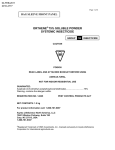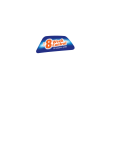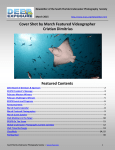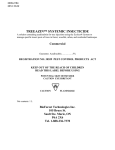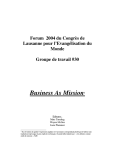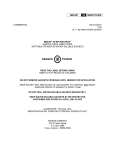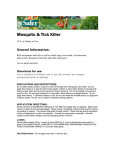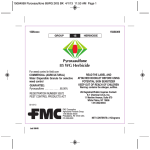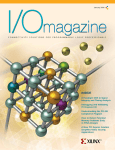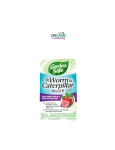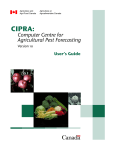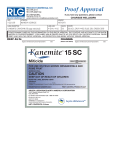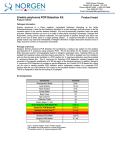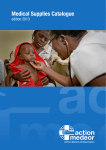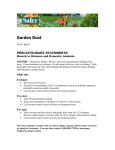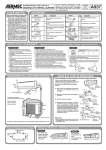Download orthene 75% soluble powder systemic insecticide
Transcript
27-MAR-2008 Sub. No. 2007-4261 26-NOV-2008 Notification - Change in Registrant Name BAG SLEEVE FRONT PANEL ORTHENE® 75% SOLUBLE POWDER SYSTEMIC INSECTICIDE GROUP 1B INSECTICIDE CAUTION POISON READ LABEL AND ATTACHED BOOKLET BEFORE USING AGRICULTURAL NOT FOR INDOOR RESIDENTIAL USE GUARANTEE: Acephate (O,S-dimethyl acetylphosphoramidothioate)...............................75% Warning, contains the allergen sulfite. REGISTRATION NO. 14225 PEST CONTROL PRODUCTS ACT NET CONTENTS: 1.5 kg For product information call: 1-866-761-9397 Arysta Lifescience North America, LLC Arysta LifeScience North America Corporation 15401 Weston Parkway, Suite 150 Cary, NC 27513 Notification Change Arysta Lifescience North America, LLC ® Registered Trademark of OMS Investments, Inc., licensed exclusively to Arysta LifeScience Corporation for international agricultural use. BACK PANEL PRECAUTIONS Harmful if swallowed. May be irritating to the eyes. Do not breathe spray mist. Avoid eye or skin contact with spray mist. KEEP OUT OF REACH OF CHILDREN AND UNAUTHORIZED PERSONNEL. Do not contaminate lakes, streams or ponds. Avoid contamination of feed and foodstuffs. Do not apply under conditions involving possible drift to food, forage or other plantings that might be damaged or the crops thereof rendered unfit for sale, use or consumption. Store in Cool, Dry Place. Protect from Excessive Heat. PERSONAL PROTECTIVE EQUIPMENT Mixing/Loading/Application: A. Mixing and loading in all agricultural scenarios • Mixers/loaders must wear maximum level PPE (i.e., chemical-resistant coveralls over a long-sleeved shirt and long pants, chemical-resistant gloves and a respirator). B. Applying using groundboom and soil injection equipment • Applicators must wear cotton coveralls over a long-sleeved shirt and long pants, chemical-resistant gloves and a respirator. • When handling 24 kg a.i. or less in one day (e.g., approximately 18 ha at highest agricultural rate of 1.31 kg a.i./ha), workers may use an open cab. • When handling more than 24 kg a.i. in one day, workers must use a closed cab (no gloves or respirator are required in a closed cab) or wear maximum level PPE (chemical-resistant coveralls over a long-sleeved shirt and long pants, chemicalresistant gloves and a respirator). C. Applying using airblast (mist-blower) equipment • Applicators must use a closed cab and wear a long-sleeved shirt and long pants. No gloves or respirator are required in a closed cab. • If the use of a closed cab is not feasible, applicators may use an open cab and wear maximum level PPE (i.e., chemical-resistant coveralls over a long-sleeved shirt and long pants, chemical-resistant gloves and a respirator) and a chemicalresistant headgear. D. Applying using handheld equipment • Mixers/loaders/applicators must wear cotton coveralls over a long-sleeved shirt and long pants, chemical-resistant gloves and a respirator. • Mixers/loaders/applicators must not handle more than 1500 L/day of diluted product. If this pest control product is to be used on a commodity that may be exported to the U.S. and you require information on acceptable residue levels in the U. S., visit CropLife Canada’s website at www.croplife.ca ENVIRONMENTAL HAZARDS TOXIC to bees exposed to direct treatment, drift or residues on flowering crops or weeds. DO NOT apply this product to flowering crops or weeds if bees are visiting the treatment area. Minimize the spray drift to reduce harmful effects on bees in habitats close to the application site. TOXIC to birds and wild mammals. Applications may adversely affect birds and wildlife visiting the treatment area. The use of this product may result in contamination of groundwater particularly in areas where soils are permeable (e.g., sandy soil) and/or the depth to the water table is shallow. TOXIC to aquatic organisms. Observe buffer zones as specified under DIRECTIONS FOR USE. FIRST AID IF SWALLOWED, call a poison control centre or doctor immediately for treatment advice. Have person sip a glass of water if able to swallow. Do not induce vomiting unless told to do so by a poison control centre or doctor. Do not give anything by mouth to an unconscious person. IF ON SKIN OR CLOTHING, take off contaminated clothing. Rinse skin immediately with plenty of water for 15–20 minutes. Call a poison control centre or doctor for treatment advice. IF INHALED, move person to fresh air. If person is not breathing, call 911 or an ambulance, then give artificial respiration, preferably by mouth-to-mouth, if possible. Call a poison control centre or doctor for further treatment advice. IF IN EYES, hold eye open and rinse slowly and gently with water for 15–20 minutes. Remove contact lenses, if present, after the first 5 minutes, then continue rinsing eye. Call a poison control centre or doctor for treatment advice. Take container, label or product name and Pest Control Product Registration Number with you when seeking medical attention. TOXICOLOGICAL INFORMATION Acephate is an organophosphate that is a cholinesterase inhibitor. Typical symptoms of overexposure to cholinesterase inhibitors include headache, nausea, dizziness, sweating, salivation, runny nose and eyes. This may progress to muscle twitching, weakness, tremors, incoordination, vomiting, abdominal cramps and diarrhea in more serious poisonings. A life-threatening poisoning is signified by loss of consciousness, incontinence, convulsions, and respiratory depression with a secondary cardiovascular component. Treat symptomatically. If exposed, plasma and red blood cell cholinesterase tests may indicate degree of exposure (baseline data are useful). Atropine, only by injection, is the preferable antidote. Oximes, such as pralidoxime chloride, may be therapeutic if used early; however, use only in conjunction with atropine. In cases of sever acute poisoning, use antidotes immediately after establishing an open airway and respiration. With oral exposure, the decision of whether to induce vomiting or not should be made by an attending physician. DECONTAMINATION NOTE: Hydrated limes, Hypochlorite oxidants, and other alkaline material should NOT be used in clean up procedures. Spills of POWDERS should be scooped into disposable containers. If ORTHENE LIQUIDS are spilled, spread a heavy clay absorbent over spill. Shovel material into disposable container. DISPOSAL 1. Triple or pressure rinse the empty container. Add the rinsings to the spray mixture in the tank. 2. Follow provincial instructions for any required additional cleaning of the container prior to its disposal. 3. Make the empty container unsuitable for further use. 4. Dispose of the container in accordance with provincial requirements. 5. For further information on the disposal of unused, unwanted product contact the manufacturer or the provincial regulatory agency. Contact the manufacturer and the provincial regulatory agency in case of spills and for clean-up of spills. NOTICE TO USER This pest control product is to be used only in accordance with the directions on the label. It is an offence under the PEST CONTROL PRODUCTS ACT to use this product in a way that is inconsistent with the directions on the label. The user assumes the risk to persons or property that arises from any such use of this product. 27-MAR-2008 Sub. No. 2007-4261 BOOKLET ORTHENE® 75% SOLUBLE POWDER SYSTEMIC INSECTICIDE GROUP 1B INSECTICIDE CAUTION POISON READ LABEL BEFORE USING AGRICULTURAL NOT FOR INDOOR RESIDENTIAL USE GUARANTEE: *Acephate (O,S-dimethyl acetylphosphoramidothioate)............................................75% Warning, contains the allergen sulfite. REGISTRATION NO. 14225 PEST CONTROL PRODUCTS ACT NET CONTENTS: 1.5 kg Notification Change For product information call: 1-866-761-9397 Arysta LifeScience North America Corporation Arysta Lifescience North America, LLC 15401 Weston Parkway, Suite 150 Cary, NC 27513 Arysta Lifescience North America, LLC ® Registered Trademark of OMS Investments, Inc., licensed exclusively to Arysta LifeScience Corporation for international agricultural use. READ ENTIRE LABEL. USE STRICTLY IN ACCORDANCE WITH LABEL CAUTIONS, WARNINGS AND DIRECTIONS. KEEP PESTICIDE IN ORIGINAL CONTAINER. DO NOT PUT CONCENTRATE OR DILUTE INTO FOOD OR DRINK CONTAINERS. PRECAUTIONS Harmful if swallowed. May be irritating to the eyes. Do not breathe spray mist. Avoid eye or skin contact with spray mist. KEEP OUT OF REACH OF CHILDREN AND UNAUTHORIZED PERSONNEL. Do not contaminate lakes, streams or ponds. Avoid contamination of feed and foodstuffs. Do not apply under conditions involving possible drift to food, forage or other plantings that might be damaged or the crops thereof rendered unfit for sale, use or consumption. Store in cool, dry place. Protect from excessive heat. PERSONAL PROTECTIVE EQUIPMENT Mixing/Loading/Application: A. Mixing and loading in all agricultural scenarios • Mixers/loaders must wear maximum level PPE (i.e., chemical-resistant coveralls over a long-sleeved shirt and long pants, chemical-resistant gloves and a respirator). B. Applying using groundboom and soil injection equipment • Applicators must wear cotton coveralls over a long-sleeved shirt and long pants, chemical-resistant gloves and a respirator. • When handling 24 kg a.i. or less in one day (e.g., approximately 18 ha at highest agricultural rate of 1.31 kg a.i./ha), workers may use an open cab. • When handling more than 24 kg a.i. in one day, workers must use a closed cab (no gloves or respirator are required in a closed cab) or wear maximum level PPE (chemical-resistant coveralls over a long-sleeved shirt and long pants, chemicalresistant gloves and a respirator). C. Applying using airblast (mist-blower) equipment • Applicators must use a closed cab and wear a long-sleeved shirt and long pants. No gloves or respirator are required in a closed cab. • If the use of a closed cab is not feasible, applicators may use an open cab and wear maximum level PPE (i.e., chemical-resistant coveralls over a long-sleeved shirt and long pants, chemical-resistant gloves and a respirator) and a chemicalresistant headgear. D. Applying using handheld equipment • Mixers/loaders/applicators must wear cotton coveralls over a long-sleeved shirt and long pants, chemical-resistant gloves and a respirator. • Mixers/loaders/applicators must not handle more than 1500 L/day of diluted product. Post application: • Do not enter or allow worker entry into treated areas during the re-entry intervals (REIs) as listed below: Brussels sprouts Cabbage Cauliflower Celery Corn Cranberries Lettuce Peppers Potatoes Cut flowers/roses Saskatoon berries Tobacco Tomatoes Ornamentals Trees 12 hours 12 hours 12 hours 1 day* 5 days* 12 hours 1 day* 1 day 1 day* 1 day 3 days 1 day* 12 hours 12 hours 3 days* * Workers conducting activities that involve significant foliar contact must wear gloves and cotton covers for the following time after the REI: Corn Celery Lettuce Tobacco Potatoes Trees 4 2 2 2 1 1 weeks weeks weeks weeks week week" If this pest control product is to be used on a commodity that may be exported to the U.S. and you require information on acceptable residue levels in the U. S., visit CropLife Canada’s website at www.croplife.ca ENVIRONMENTAL HAZARDS TOXIC to bees exposed to direct treatment, drift or residues on flowering crops or weeds. DO NOT apply this product to flowering crops or weeds if bees are visiting the treatment area. Minimize the spray drift to reduce harmful effects on bees in habitats close to the application site. TOXIC to birds and wild mammals. Applications may adversely affect birds and wildlife visiting the treatment area. The use of this product may result in contamination of groundwater particularly in areas where soils are permeable (e.g., sandy soil) and/or the depth to the water table is shallow. TOXIC to aquatic organisms. Observe buffer zones as specified under DIRECTIONS FOR USE. FIRST AID IF SWALLOWED, call a poison control centre or doctor immediately for treatment advice. Have person sip a glass of water if able to swallow. Do not induce vomiting unless told to do so by a poison control centre or doctor. Do not give anything by mouth to an unconscious person. IF ON SKIN OR CLOTHING, take off contaminated clothing. Rinse skin immediately with plenty of water for 15–20 minutes. Call a poison control centre or doctor for treatment advice. IF INHALED, move person to fresh air. If person is not breathing, call 911 or an ambulance, then give artificial respiration, preferably by mouth-to-mouth, if possible. Call a poison control centre or doctor for further treatment advice. IF IN EYES, hold eye open and rinse slowly and gently with water for 15–20 minutes. Remove contact lenses, if present, after the first 5 minutes, then continue rinsing eye. Call a poison control centre or doctor for treatment advice. Take container, label or product name and Pest Control Product Registration Number with you when seeking medical attention. TOXICOLOGICAL INFORMATION Acephate is an organophosphate that is a cholinesterase inhibitor. Typical symptoms of overexposure to cholinesterase inhibitors include headache, nausea, dizziness, sweating, salivation, runny nose and eyes. This may progress to muscle twitching, weakness, tremors, incoordination, vomiting, abdominal cramps and diarrhea in more serious poisonings. A lifethreatening poisoning is signified by loss of consciousness, incontinence, convulsions, and respiratory depression with a secondary cardiovascular component. Treat symptomatically. If exposed, plasma and red blood cell cholinesterase tests may indicate degree of exposure (baseline data are useful). Atropine, only by injection, is the preferable antidote. Oximes, such as pralidoxime chloride, may be therapeutic if used early; however, use only in conjunction with atropine. In cases of sever acute poisoning, use antidotes immediately after establishing an open airway and respiration. With oral exposure, the decision of whether to induce vomiting or not should be made by an attending physician. DECONTAMINATION NOTE: Hydrated limes, Hypochlorite oxidants, and other alkaline material should NOT be used in clean up procedures. Spills of POWDERS should be scooped into disposable containers. If ORTHENE LIQUIDS are spilled, spread a heavy clay absorbent over spill. Shovel material into disposable container. DISPOSAL 1. Triple or pressure rinse the empty container. Add the rinsings to the spray mixture in the tank. 2. Follow provincial instructions for any required additional cleaning of the container prior to its disposal. 3. Make the empty container unsuitable for further use. 4. Dispose of the container in accordance with provincial requirements. For further information on the disposal of unused, unwanted product contact the manufacturer or the provincial regulatory agency. Contact the manufacturer and the provincial regulatory agency in case of spills and for clean-up of spills. NOTICE TO USER This pest control product is to be used only in accordance with the directions on the label. It is an offence under the PEST CONTROL PRODUCTS ACT to use this product in a way that is inconsistent with the directions on the label. The user assumes the risk to persons or property that arises from any such use of this product. DIRECTIONS FOR USE ON CROPS Apply with ground application equipment only. APPLICATION EQUIPMENT. NOT TO BE APPLIED BY AERIAL DO NOT apply this product directly to freshwater habitats (such as lakes, rivers, sloughs, ponds, prairie potholes, creeks, marshes, streams, reservoirs, ditches and wetlands), estuaries or marine habitats. Field sprayer application: DO NOT apply during periods of dead calm. Avoid application of this product when winds are gusty. DO NOT apply with spray droplets smaller than the American Society of Agricultural Engineers (ASAE) fine classification. Airblast application: DO NOT apply during periods of dead calm. Avoid application of this product when winds are gusty. DO NOT direct spray above plants to be treated. Turn off outward pointing nozzles at row ends and outer rows. DO NOT apply when wind speed is greater than 16 km/h at the application site as measured outside of the treatment area on the upwind side. Buffer Zones: The buffer zones specified in the table below are required between the point of direct application and the closest downwind edge of (1) sensitive freshwater habitats (such as lakes, rivers, sloughs, ponds, prairie potholes, creeks, marshes, streams, reservoirs and wetlands), and (2) estuarine or marine habitats. Method of Application Field sprayer* Airblast (early growth stage) Buffer Zone (metres) Required for the Protection of Aquatic Habitat With Water Depth of: < 1 metre 1 – 3 metres > 3 metres 15 5 0 25 10 3 *For field sprayer application, buffer zones can be reduced with the use of drift reducing spray shields. When using a spray boom fitted with a full shield (shroud, curtain) that extends to the crop canopy or ground, the labeled buffer zone can be reduced by 70%. When using a spray boom where individual nozzles are fitted with cone-shaped shields that are no more than 30 cm above the crop canopy or ground, the labeled buffer zone can be reduced by 30%. RESISTANCE MANAGEMENT For resistance management, please note that ORTHENE 75% SOLUBLE POWDER contains a Group 1B insecticide. Any insect population may contain individuals naturally resistant to ORTHENE 75% SOLUBLE POWDER and other Group 1B insecticides. The resistant individuals may dominate the insect population if this group of insecticides are used repeatedly in the same fields. Other resistance mechanisms that are not linked to site of action but are specific for individual chemicals, such as enhanced metabolism, may also exist. Appropriate resistance-management strategies should be followed. To delay insecticide resistance: • Where possible, rotate the use of ORTHENE 75% SOLUBLE POWDER or other Group 1B insecticides with different groups that control the same pests in a field. • Use tank mixtures with insecticides from a different group when such use is permitted. • Insecticide use should be based on an IPM program that includes scouting, record keeping, and considers cultural, biological and other chemical control practices. • Monitor treated pest population for resistance development. • Contact your local extension specialist or certified crop advisors for any additional pesticide resistance-management and/or IPM recommendations for the specific site and Arysta Lifescience North America, LLC pest problems in your area. • For further information or to report suspected resistance contact Arysta LifeScience North America Corporation at 1-866-761-9397. Notification Change GENERAL APPLICATON INSTRUCTIONS AND LIMITATIONS DO NOT handle more than 1500 L of diluted spray solution per day when using hand-held spray equipment. Mix thoroughly and spray entire plant covering both sides of foliage. Spray when insects are present or feeding injury is first noticed. Repeat if re-infestation occurs. SITE Cabbage, Brussels Sprouts, Cauliflower PESTS Cabbage looper, Imported cabbageworm, Diamondback moth larvae, Green peach aphid RATE (a.i.) 563-825 g/ha APPLICATION INSTRUCTIONS AND LIMITATIONS Apply in 225 to 1650 L of water using conventional ground application equipment. Use the high rate only when heavy pest infestations are present. Do not feed trimmings to livestock or allow animals to graze on treated areas. Do not apply more than 2 applications per season. Re-entry Interval (REI): 12 hours Preharvest Interval (PHI): 28 days SITE Head lettuce (crisp head type only) PESTS Cabbage looper, Imported cabbageworm, Diamondback moth larvae, Green peach aphid RATE (a.i.) 563-825 g/ha APPLICATION INSTRUCTIONS AND LIMITATIONS Apply in 225 to 1650 L of water using conventional ground application equipment. Use the high rate only when heavy pest infestations are present. Do not feed trimmings to livestock or allow animals to graze on treated areas. Do not apply more than 4 applications per season. Re-entry Interval (REI): 1 day Workers re-entering this crop and conducting activities that involve significant foliar contact must wear gloves and cotton coveralls for 2 weeks after the REI. PHI: 7 days Celery Green peach aphid, Tarnished plant bug 563-825 g/ha Apply in 225 to 1650 L of water. Apply with ground equipment only. Apply when insects reach economic threshold levels. Do not apply more than 4 applications per season. REI: 1 day Workers re-entering this crop and conducting activities that involve significant foliar contact must wear gloves and cotton coveralls for 2 weeks after the REI. PHI: 21 days Corn (Seed and Sweet) European corn borer 563-825 g/ha Apply in 220 to 1000 L of spray mix using conventional ground application equipment. Use the high rate only when heavy pest infestations are present. For European corn borer, apply when egg mass count indicates an economically damaging population. Do not feed corn fodder or forage from treated crop to livestock. Do not apply more than 4 applications per season. REI: 5 days Workers re-entering this crop and conducting activities that involve SITE PESTS RATE (a.i.) APPLICATION INSTRUCTIONS AND LIMITATIONS significant foliar contact must wear gloves and cotton coveralls for 4 weeks after the REI. PHI: 21 days Potato Green peach aphid, Potato aphid, Potato flea beetle, Potato leafhopper, Tarnished plant bug 563-825 g/ha Apply in 225 to 1650 L of water per hectare using conventional ground application equipment. Use the high rate only when heavy pest infestations are present. Begin applications at first sign of insects and repeat on a 7- to 10-day schedule as necessary. Do not apply more than 4 applications per season. REI: 1 day Workers re-entering this crop and conducting activities that involve significant foliar contact must wear gloves and cotton coveralls for 1 week after the REI. PHI: 21 days Saskatoon berries (nonbearing Woolly elm aphid 637 mg/L 1275 mg/plant Soil Injection Application: Provides control of woolly elm aphid in non-bearing Saskatoon berry plants. Can be used in first three years of establishment. Apply once per year in mid July or early August. Mix 637 mg a.i./L of water (equivalent to 6.37 g a.i./10 L of water). Apply 2 litres of this solution per plant. The solution is injected with a probe; 3 to 5 injections for each plant to a depth of 12 cm. The injection should be made 15 cm from the stem of the plant. DO NOT enter or allow worker entry into treated areas during the restricted entry interval (REI) of 3 days Saskatoon berries (bearing) Woolly elm aphid Woolly apple aphid 637 mg/L 1275 mg/plant Soil Injection Application: Provides control of woolly elm aphid and woolly apple aphid in bearing Saskatoon berry plants. Apply once per year in mid July or early August after harvest is complete. SITE PESTS RATE (a.i.) APPLICATION INSTRUCTIONS AND LIMITATIONS Mix 637 mg a.i./L of water (equivalent to 6.37 g ai.i/10 L of water). Apply 2 litres of this solution per plant. The solution is injected with a probe; 3 to 5 injections for each plant to a depth of 12 cm. The injection should be made 15 cm from the stem of the plant. A rate of 1.7 g product per plant and a planting density of 2000 plants per hectare is a rate of 3.4 kg/ha. DO NOT enter or allow worker entry into treated areas during the restricted entry interval (REI) of 3 days. PHI: 11 months Sweet Pepper (Bell type) Green peach aphid, Pepper maggot 562 g/ha European corn borer 825 g/ha Apply in 225 to 1650 L of water with conventional ground application equipment. Begin applications when eggs or insects appear. Maintain a 7- to 10-day spray schedule until insects have been reduced below economic levels. Do not apply more than 4 applications per season. REI: 1 day PHI: 7 days Tobacco (Flue cured) Tomato hornworm, Flea beetle, Green peach aphid 563-825 g/ha Apply in at least 100 L of water using conventional ground application equipment. Apply on a 7-day schedule or as needed. Use 825 g a.i./ha for control of established populations. REI: 1 day Workers re-entering this crop and conducting activities that involve significant foliar contact must wear gloves and cotton coveralls for 2 weeks after the REI. PHI: 3 days Darksided cutworm (pre-plant) 563 g/ha (cover crop treatment) 1125 g/ha (soil treatment) Treat either the rye or wheat cover crop or the soil using at least 200 L of water per hectare. Applications are most effective when applied late afternoon or early evening when temperatures are 13°C or higher. Apply soon after the cutworms have hatched (mid to late April, SITE PESTS RATE (a.i.) APPLICATION INSTRUCTIONS AND LIMITATIONS 4 to 5 days before plowing.) REI: 1 day Workers re-entering this crop and conducting activities that involve significant foliar contact must wear gloves and cotton coveralls for 2 weeks after the REI. Darksided cutworm (post-plant) 1125 g/ha Apply in sufficient water to give good coverage of seedlings. Apply in the late afternoon or evening. REI: 1 day Workers re-entering this crop and conducting activities that involve significant foliar contact must wear gloves and cotton coveralls for 2 weeks after the REI. Tobacco Darksided cutworm, Potato flea beetle, Root maggot, Green peach aphid, Thrips 825 –1275 g/ha Transplant water treatment: Provides control for approximately 2 to 3 weeks after transplanting. Apply in a minimum of 1200 L of transplant water per hectare. Do not apply more than 1275 g a.i./ha as a transplant water application as some phytotoxicity may occur. REI: 1 day Workers re-entering this crop and conducting activities that involve significant foliar contact must wear gloves and cotton coveralls for 2 weeks after the REI. Wireworm 825 g/ha Transplant water treatment: Apply in 1200 L of transplant water per hectare. Make one application per season at transplanting. REI: 1 day Workers re-entering this crop and conducting activities that involve significant foliar contact must wear gloves and cotton coveralls for 2 weeks after the REI. Cranberry Blackheaded fireworm 562 g/ha Apply one prebloom application to control the first generation of blackheaded fireworm where field scouting indicates insect numbers warrant treatment. Apply in 225 to 1650 L of water per hectare SITE PESTS RATE (a.i.) APPLICATION INSTRUCTIONS AND LIMITATIONS using conventional ground equipment. A second application may be made post bloom if insect numbers indicate it is required. REI: 12 hours Tomato Cutworms, Potato flea beetle, Root maggots, Wireworms, Aphids, Thrips, Colorado potato beetle 900 g/ha Transplant water application: To provide control of listed pests for approximately 2 to 3 weeks after transplanting, apply in 2000 L of water per hectare. This rate is based on 14,000 plants per hectare. REI: 12 hours DIRECTIONS FOR USE ON TREES AND ORNAMENTALS ORTHENE 75% SOLUBLE POWDER SYSTEMIC INSECTICIDE effectively controls many insects that attack flowers, ornamentals, shrubs, trees and roses (outdoors and in the greenhouse). ORTHENE 75% SOLUBLE POWDER SYSTEMIC INSECTICIDE controls insects that are present and remains effective for an extended period of time because it is systematically absorbed by plants. Cut flowers (greenhouse and field): DO NOT apply more than 0.83 kg a.i./ha Other ornamentals and trees: DO NOT apply more than 1.31 kg a.i./ha Re-entry Interval (REI) for ornamental shrubs and flowers (except for roses): 12 hours REI for trees: 3 days (workers re-entering this crop and conducting activities that involve significant foliar contact must wear gloves and cotton coveralls for 1 week after the REI.) REI for cut flowers/roses: 1 day SITE PESTS Abelia, Forsythia, Fruitless Mulberry, Laurel, Magnolia Scale insect (crawlers: cottony maple, hemlock, oystershell, cottony cushion, lecanium) Alyssum, Daisy Flower thrips Bottlebrush, Honey locust Spider mites (except twospotted) Camellia Greenhouse whitefly, Mealybug, Scale insect (crawlers: cottony maple, hemlock, oystershell, cottony cushion, lecanium), RATE (a.i.) Mist blower: 1312 g/1000 L Hydraulic sprayer: 637 g/1000 L Mist blower: 1312 g/1000 L Hydraulic sprayer: 637 g/1000 L APPLICATION INSTRUCTIONS AND LIMITATIONS Mix thoroughly and spray entire plant covering both sides of foliage. Spray when insects are present or feeding injury is first noticed. Spray 2 times, 7 to 10 days apart. Mix thoroughly and spray entire plant covering both sides of foliage. Spray when insects are present or feeding injury is first noticed. Spray 2 times, 7 to 10 days apart. SITE PESTS RATE (a.i.) APPLICATION INSTRUCTIONS AND LIMITATIONS Spider mites (except twospotted) Daylily Flower thrips, Two-spotted spider mite Mist blower: 1312 g/1000 L Gladiolus Flower thrips, Gladiolus thrips Hydraulic sprayer: 637 g/1000 L Lantana Greenhouse whitefly Pachysandra, Phlox Two-spotted spider mite Yew (taxus) Mealybug Yucca Flower thrips, Scale insect (crawlers: cottony maple, hemlock, oystershell, cottony cushion, lecanioum) Alder Fall webworm, Leafminer, Psyllids Ash Aphid, Fall webworm, Gypsy moth, Lace bug, Sawflies (open feeders: blackheaded ash), Tent caterpillar (eastern and forest), Tussock moth Aspen, Bloodleaf (Iresine), Dusty miller, Flowering almond, Flowering quince, Gazania, Mock orange, Photinia, Pittosporum, Tulip Aphid Boston ivy Potato leafhopper Cedar Bagworm, Gypsy moth Mist blower: 1312 g/1000 L Hydraulic sprayer: 637 g/1000 L Mist blower: 1312 g/1000 L Hydraulic Mix thoroughly and spray entire plant covering both sides of foliage. Spray when insects are present or feeding injury is first noticed. Spray 2 times, 7 to 10 days apart. Mix thoroughly and spray entire plant covering both sides of foliage. Spray when insects are present or feeding injury is first noticed. Repeat application once only, if re-infestation occurs. Mix thoroughly and spray entire plant covering both sides of foliage. Spray when insects are present or feeding injury is first SITE PESTS Cockspur thorn Cankerworm (spring and fall) Deutzia Aphid, Leafminer Flowering plum Aphid, Tent caterpillar (eastern and forest) Hawthorn Aphid, Cankerworm (spring and fall), Gypsy moth, Tent caterpillar (eastern and forest) Larch Sawflies (open feeders: redheaded pine sawfly) Linden Aphid, Bagworm, Cankerworm (spring and fall), Fall webworm, Tussock moth, Yellownecked caterpillar Locust Leafminer Poplar Aphid, Fall webworm, Gypsy moth, Poplar tentmaker, Tent caterpillar (eastern and forest), Tussock moth RATE (a.i.) sprayer: 637 g/1000 L Mist blower: 1312 g/1000 L Hydraulic sprayer: 637 g/1000 L APPLICATION INSTRUCTIONS AND LIMITATIONS noticed. Repeat application once only, if re-infestation occurs. Mix thoroughly and spray entire plant covering both sides of foliage. Spray when insects are present or feeding injury is first noticed. Repeat application once only, if re-infestation occurs. SITE PESTS Rhododendron Lace bug Silver maple Cankerworm (spring and fall) Slippery elm Casebearers Spirea Aphid, Obliquebanded leafroller Staghorn sumac Obliquebanded leafroller Sumac Psyllids Sweet gum Bagworm Sycamore Aphid, Bagworm, Casebearers, Fall webworm, Lace bug, Obliquebanded leafroller, Tussock moth Shade trees, Ornamentals, Shelterbeds (such as Cotoneaster, Willow, Mountain ash and Pincherry) Pear slug (pear sawfly larvae) Wild cherry Tussock moth Arborvitae Aphid, Bagworm, Spider mites (except twospotted) RATE (a.i.) Mist blower: 1312 g/1000 L Hydraulic sprayer: 637 g/1000 L Mist blower: 1312 g/1000 L Hydraulic sprayer: 637 g/1000 L APPLICATION INSTRUCTIONS AND LIMITATIONS Mix thoroughly and spray entire plant covering both sides of foliage. Spray when insects are present or feeding injury is first noticed. Repeat application once only, if re-infestation occurs. Mix thoroughly and spray entire plant covering both sides of foliage. Spray when insects are present or feeding injury is first noticed. Repeat application once only, if re-infestation occurs. To control spider mites, spray 2 times, 7 to 10 days apart. Aster Aphid, Armyworm (fall, beet and yellowstriped), Flower thrips, Leafminer Mist blower: 1312 g/1000 L Hydraulic sprayer: 637 g/1000 L Mix thoroughly and spray entire plant covering both sides of foliage. Spray when insects are present or feeding injury is first noticed. Repeat application once only, if re-infestation occurs. SITE Azalea Barberry, Ligustrum, Mahonia PESTS RATE (a.i.) Aphid, Greenhouse whitefly, Lace bug, Mealybug, Scale insect (crawlers: cottony maple, hemlock, oystershell, cottony cushion, lecanium), Spider mites (except twospotted) Mist blower: 1312 g/1000 L Aphid, Greenhouse whitefly Mist blower: 1312 g/1000 L Hydraulic sprayer: 637 g/1000 L APPLICATION INSTRUCTIONS AND LIMITATIONS To control flower thrips, spray 2 times, 7 to 10 days apart. Mix thoroughly and spray entire plant covering both sides of foliage. Spray when insects are present or feeding injury is first noticed. Repeat application once only, if re-infestation occurs. To control greenhouse whitefly, mealybug, scale insects and spider mites (other than two-spotted), spray 2 times, 7 to 10 days apart. Hydraulic sprayer: 637 g/1000 L Mix thoroughly and spray entire plant covering both sides of foliage. Spray when insects are present or feeding injury is first noticed. Repeat application once only, if re-infestation occurs. To control greenhouse whitefly, spray 2 times, 7 to 10 days apart. Boxwood, Euonymous, Hibiscus, Nandina, Rose of Sharon Aphid, Scale insect (crawlers: cottony maple, hemlock, oystershell, cottony cushion, lecanium) Mist blower: 1312 g/1000 L Hydraulic sprayer: 637 g/1000 L Mix thoroughly and spray entire plant covering both sides of foliage. Spray when insects are present or feeding injury is first noticed. Repeat application once only, if re-infestation occurs. To control scale insects, spray 2 times, 7 to 10 days apart. Calendula Aphid, Armyworm (fall, beet and yellowstriped), Flower thrips, Potato leafhopper, Tobacco budworm Mist blower: 1312 g/1000 L Hydraulic sprayer: 637 g/1000 L Mix thoroughly and spray entire plant covering both sides of foliage. Spray when insects are present or feeding injury is first noticed. Repeat application once only, if re-infestation occurs. To control flower thrips, spray 2 times, 7 to 10 days apart. Cotoneaster Aphid, Lace bug, Scale insect (crawlers: cottony maple, hemlock, oystershell, cottony cushion, lecanium) Mist blower: 1312 g/1000 L Hydraulic sprayer: 637 g/1000 L Mix thoroughly and spray entire plant covering both sides of foliage. Spray when insects are present or feeding injury is first noticed. Repeat application once only, if re-infestation occurs. To control scale insects, spray 2 times, 7 to 10 days apart. SITE Cypress Dahlia PESTS RATE (a.i.) Bagworm, Scale insect (crawlers: cottony maple, hemlock, oystershell, cottony cushion, lecanium), Spider mites Mist blower: 1312 g/1000 L Armyworm (fall, beet and yellowstriped), Potato leafhopper, Two-spotted spider mite Mist blower: 1312 g/1000 L Hydraulic sprayer: 637 g/1000 L APPLICATION INSTRUCTIONS AND LIMITATIONS Mix thoroughly and spray entire plant covering both sides of foliage. Spray when insects are present or feeding injury is first noticed. Repeat application once only, if re-infestation occurs. To control scale insects and spider mites, spray 2 times, 7 to 10 days apart. Hydraulic sprayer: 637 g/1000 L Mix thoroughly and spray entire plant covering both sides of foliage. Spray when insects are present or feeding injury is first noticed. Repeat application once only, if re-infestation occurs. To control two-spotted spider mites, spray 2 times, 7 to 10 days apart. Elm (Chinese or Siberian) Elm leaf beetle (larvae), Tussock moth, Armyworm (fall, beet and yellowstriped) on Chinese elm only, Scale insect (crawlers: cottony maple, hemlock, oystershell, cottony cushion, lecanium) on Chinese Elm only Geranium Tobacco budworm, Scale insect (crawlers: cottony maple, hemlock, oystershell, cottony cushion, lecanium) Hackberry Psyllids, Scale insect (crawlers: cottony maple, hemlock, oystershell, cottony cushion, lecanium) Hemlock Gypsy moth, Scale insect (crawlers: cottony maple, hemlock, oystershell, cottony cusion, Mist blower: 1312 g/1000 L Hydraulic sprayer: 637 g/1000 L Mix thoroughly and spray entire plant covering both sides of foliage. Spray when insects are present or feeding injury is first noticed. Repeat application once only, if re-infestation occurs. To control scale insects, spray 2 times, 7 to 10 days apart. Mist blower: 1312 g/1000 L Hydraulic sprayer: Mix thoroughly and spray entire plant covering both sides of foliage. Spray when insects are present or feeding injury is first noticed. Repeat application once SITE Holly Hydrangea, Primrose PESTS RATE (a.i.) lecanium), Spider mites (except twospotted) 637 g/1000 L Leafminer, Obliquebanded leafroller, Psyllids, Tussock moth, Scale insect (crawlers: cottony maple, hemlock, oystershell, cottony cushion, lecanium), Spider mites (except twospotted) Mist blower: 1312 g/1000 L Aphid, Two-spotted mite Mist blower: 1312 g/1000 L APPLICATION INSTRUCTIONS AND LIMITATIONS only, if re-infestation occurs. To control scale insects and spider mites (other than two-spotted spider mite), spray 2 times, 7 to 10 days apart. Hydraulic sprayer: 637 g/1000 L Mix thoroughly and spray entire plant covering both sides of foliage. Spray when insects are present or feeding injury is first noticed. Repeat application once only, if re-infestation occurs. To control scale insects and spider mites (other than two-spotted spider mite), spray 2 times, 7 to 10 days apart. Hydraulic sprayer: 637 g/1000 L Mix thoroughly and spray entire plant covering both sides of foliage. Spray when insects are present or feeding injury is first noticed. Repeat application once only, if re-infestation occurs. To control two-spotted spider mites, spray 2 times, 7 to 10 days apart. Ivy Aphid, Mealybug Mist blower: 1312 g/1000 L Hydraulic sprayer: 637 g/1000 L Mix thoroughly and spray entire plant covering both sides of foliage. Spray when insects are present or feeding injury is first noticed. Repeat application once only, if re-infestation occurs. To control mealybugs, spray 2 times, 7 to 10 days apart. Juniper Bagworm, Meadow spittlebug, Spider mites (except twospotted) Mist blower: 1312 g/1000 L Hydraulic sprayer: 637 g/1000 L Mix thoroughly and spray entire plant covering both sides of foliage. Spray when insects are present or feeding injury is first noticed. Repeat application once only, if re-infestation occurs. To spider mites (other than twospotted spider mite), spray 2 times, 7 to 10 days apart. Lilac Aphid, Leafminer, Scale insect (crawlers: cottony maple, Mist blower: 1312 g/1000 L Hydraulic Mix thoroughly and spray entire plant covering both sides of foliage. Spray when insects are present or feeding injury is first SITE Marigold PESTS RATE (a.i.) hemlock, oystershell, cottony cushion, lecanium) sprayer: 637 g/1000 L Flower thrips, Leafminer, Sunflower moth, Two-spotted spider mite Mist blower: 1312 g/1000 L APPLICATION INSTRUCTIONS AND LIMITATIONS noticed. Repeat application once only, if re-infestation occurs. To control scale insects and spider mites (other than two-spotted spider mite), spray 2 times, 7 to 10 days apart. Hydraulic sprayer: 637 g/1000 L Mix thoroughly and spray entire plant covering both sides of foliage. Spray when insects are present or feeding injury is first noticed. Repeat application once only, if re-infestation occurs. To control flower thrips and twospotted spider mites, spray 2 times, 7 to 10 days apart. Petunia Armyworm (fall, beet and yellowstriped), Flower thrips, Tobacco budworm Mist blower: 1312 g/1000 L Hydraulic sprayer: 637 g/1000 L Mix thoroughly and spray entire plant covering both sides of foliage. Spray when insects are present or feeding injury is first noticed. Repeat application once only, if re-infestation occurs. To control flower thrips, spray 2 times, 7 to 10 days apart. Pyracantha Rose (field grown) Aphid, Lace bug, Yellownecked caterpillar, Scale insect (crawlers: cottony maple, hemlock, oystershell, cottony cushion, lecanium) Mist blower: 1312 g/1000 L Aphid, Armyworm (fall, beet and yellowstriped), Flower thrips, Meadow spittlebug, Obliquebanded leafroller, Rose midge, Tussock moth, Scale insect (crawlers: cottony maple, hemlock, oystershell, cottony cushion, lecanium), Spider mites Mist blower: 1312 g/1000 L Hydraulic sprayer: 637 g/1000 L Mix thoroughly and spray entire plant covering both sides of foliage. Spray when insects are present or feeding injury is first noticed. Repeat application once only, if re-infestation occurs. To control scale insects, spray 2 times, 7 to 10 days apart. Hydraulic sprayer: 637 g/1000 L Mix thoroughly and spray entire plant covering both sides of foliage. Spray when insects are present or feeding injury is first noticed. Repeat application once only, if re-infestation occurs. To control flower thrips, scale insects and spider mites, spray 2 times, 7 to 10 days apart. SITE Salvia PESTS Aphid, Flower thrips, Greenhouse whitefly RATE (a.i.) Mist blower: 1312 g/1000 L Hydraulic sprayer: 637 g/1000 L APPLICATION INSTRUCTIONS AND LIMITATIONS Mix thoroughly and spray entire plant covering both sides of foliage. Spray when insects are present or feeding injury is first noticed. Repeat application once only, if re-infestation occurs. To control flower thrips and greenhouse whitefly, spray 2 times, 7 to 10 days apart. Snapdragon Aphid, Armyworm (fall, beet and yellowstriped), Flower thrips, Tobacco budworm Mist blower: 1312 g/1000 L Hydraulic sprayer: 637 g/1000 L Mix thoroughly and spray entire plant covering both sides of foliage. Spray when insects are present or feeding injury is first noticed. Repeat application once only, if re-infestation occurs. To control flower thrips, spray 2 times, 7 to 10 days apart. Viburnum Aphid, Greenhouse whitefly, Two-spotted spider mite Mist blower: 1312 g/1000 L Hydraulic sprayer: 637 g/1000 L Mix thoroughly and spray entire plant covering both sides of foliage. Spray when insects are present or feeding injury is first noticed. Repeat application once only, if re-infestation occurs. To control greenhouse whitefly and two-spotted spider mite, spray 2 times, 7 to 10 days apart. Willow Wisteria Aphid, Bagworm, Willow leaf beetle (larvae), Fall webworm, Gypsy moth, Poplar tentmaker, Psyllids, Sawflies (open feeders: dusky birch), Tent caterpillar (eastern and forest), Tussock moth, Scale insect (crawlers: cottony maple, hemlock, oystershell, cottony cushion, lecanium) Mist blower: 1312 g/1000 L Aphid, Mealybugs, Scale insect (crawlers: Mist blower: 1312 g/1000 L Hydraulic sprayer: 637 g/1000 L Mix thoroughly and spray entire plant covering both sides of foliage. Spray when insects are present or feeding injury is first noticed. Repeat application once only, if re-infestation occurs. To control scale insects, spray 2 times, 7 to 10 days apart. Mix thoroughly and spray entire plant covering both sides of foliage. Spray when insects are SITE Zinnia PESTS RATE (a.i.) cottony maple, hemlock, oystershell, cottony cushion, lecanium) Hydraulic sprayer: 637 g/1000 L Flower thrips, Greenhouse whitefly, Lace bug, Leafminer APPLICATION INSTRUCTIONS AND LIMITATIONS present or feeding injury is first noticed. Repeat application once only, if re-infestation occurs. To control mealybugs and scale insects, spray 2 times, 7 to 10 days apart. Mist blower: 1312 g/1000 L Hydraulic sprayer: 637 g/1000 L Mix thoroughly and spray entire plant covering both sides of foliage. Spray when insects are present or feeding injury is first noticed. Repeat application once only, if re-infestation occurs. To control flower thrips and greenhouse whitefly, spray 2 times, 7 to 10 days apart. SITE Birch Fir Flowering cherry PESTS RATE (a.i.) Aphid, Cankerworm (spring and fall), Fall webworm, Gypsy moth, Leafminer, Sawflies (open feeders: dusky birch), Tent caterpillar (eastern and forest), Tussock moth, Yellownecked caterpillar Mist blower: 1312 g/1000 L Aphid, Tussock moth, Scale insect (crawlers: cottony maple, hemlock, oystershell, cottony cushion, lecanium), Fall webworm, Spider mites (except twospotted) Obliquebanded leafroller, Tent caterpillar (eastern and forest) Hydraulic sprayer: 637 g/1000 L Mist blower: 1312 g/1000 L Hydraulic sprayer: 637 g/1000 L APPLICATION INSTRUCTIONS AND LIMITATIONS Mix thoroughly and spray entire plant covering both sides of foliage. Spray when insects are present or feeding injury is first noticed. Repeat application once only, if re-infestation occurs. Mix thoroughly and spray entire plant covering both sides of foliage. Spray when insects are present or feeding injury is first noticed. Repeat application once only, if re-infestation occurs. To control scale insects and spider mites (except two-spotted spider mite), spray 2 times, 7 to 10 days apart. Mist blower: 1312 g/1000 L Hydraulic sprayer: 637 g/1000 L Mix thoroughly and spray entire plant covering both sides of foliage. Spray when insects are present or feeding injury is first noticed. Repeat application once only, if re-infestation occurs. SITE Maple Oak Pine Spruce PESTS RATE (a.i.) Aphid, Bagworm, Cankerworm (spring and fall), Gypsy moth, Potato leafhopper, Tent caterpillar (eastern and forest), Tussock moth, Scale insect (crawlers: cottony maple, hemlock, oystershell, cottony cushion, lecanium) Mist blower: 1312 g/1000 L Aphid, Cankerworm (spring and fall), Fall webworm, Gypsy moth, Lace bug, Leafminer, Obliquebanded leafroller, Oak leaf shredder (white and red oak only), Tent caterpillar (eastern and forest), Tussock moth, Yellownecked caterpillar, Scale insect (crawlers: cottony maple, hemlock, oystershell, cottony cushion, lecanium), Spider mites (except twospotted) Bagworm, Gypsy moth, Nantucket pine tip moth, Sawflies (open feeders: redheaded pine, European pine sawfly), Tussock moth, Scale insect (crawlers: cottony maple, hemlock, oystershell, cottony cusion, lecanium), Spider mites (except twospotted) Gypsy moth, Leafminer, Hydraulic sprayer: 637 g/1000 L APPLICATION INSTRUCTIONS AND LIMITATIONS Mix thoroughly and spray entire plant covering both sides of foliage. Spray when insects are present or feeding injury is first noticed. Repeat application once only, if re-infestation occurs. To control scale insects, spray 2 times, 7 to 10 days apart. Mist blower: 1312 g/1000 L Hydraulic sprayer: 637 g/1000 L Mix thoroughly and spray entire plant covering both sides of foliage. Spray when insects are present or feeding injury is first noticed. Repeat application once only, if re-infestation occurs. To control scale insects and spider mites (other than two-spotted spider mite), spray 2 times, 7 to 10 days apart. Mist blower: 1312 g/1000 L Hydraulic sprayer: 637 g/1000 L Mix thoroughly and spray entire plant covering both sides of foliage. Spray when insects are present or feeding injury is first noticed. Repeat application once only, if re-infestation occurs. To control scale insects and spider mites (other than two-spotted spider mite), spray 2 times, 7 to 10 days apart. Mist blower: 1312 g/1000 L Mix thoroughly and spray entire plant covering both sides of SITE PESTS RATE (a.i.) Sawflies (open feeders: redheaded pine, yellowheaded spruce sawfly), Tussock moth, Spider mites (except twospotted) Hydraulic sprayer: 637 g/1000 L APPLICATION INSTRUCTIONS AND LIMITATIONS foliage. Spray when insects are present or feeding injury is first noticed. Repeat application once only, if re-infestation occurs. To control spider mites (other than two-spotted spider mite), spray 2 times, 7 to 10 days apart. GREENHOUSE USE ON ROSES PESTS Aphid, Flower thrips, Omnivorous leafroller, Rose midge, Whitefly RATE (a.i.) Hydraulic sprayer: 637 g/1000 L APPLICATION INSTRUCTIONS AND LIMITATIONS Spray to wet foliage completely. Note: • DO NOT apply more than 0.83 kg a.i./ha. • DO NOT enter or allow worker entry into treated areas during the restricted entry interval (REI) of 1 day. CHRISTMAS TREE PLANTATIONS, FARM WOODLOTS, TREE NURSERIES, SHELTER BELTS, RIGHT OF WAYS, MUNICIPAL PARKS (excluding National and Provincial Parks) PESTS Aphid, Armyworm (fall, beet and yellowstriped), Bagworm, Cankerworm (fall and spring), Casebearer, Fall webworm, Flower thrips, Gladiolous thrips, Greenhouse whitefly, Gypsy moth, Lace bug, Leaf beetle larvae (elm and willow), Leafminer, Meadow spittlebug, Mealybug, Nantucket pine tip moth, Oak leafshredder, Obliquebanded leafroller, Psyllid, Pear slug (pear sawfly larvae), Poplar tentmaker, Potato leafhopper, RATE (a.i.) Hydraulic sprayer: 637 g/1000 L Mist blower: 1312 g/1000 L APPLICATION INSTRUCTIONS AND LIMITATIONS Consult Canadian Forestry Service office or provincial forestry authority for information on timing of sprays and method of application. DO NOT apply to American elm, flowering crabapple, sugar maple, cottonwood, redbud and weigelia, as foliage injury may occur. Before treating rare or unusual varieties, it is advisable to test it on a few plants before spraying large numbers. Clean sprayer after use by flushing with water. Do not use household bleach or cleaning agent. PESTS RATE (a.i.) APPLICATION INSTRUCTIONS AND LIMITATIONS Rose midge, Scale insect (crawlers: cottony maple, hemlock, oystershell, cottony cushion, lecanium), Sawflies (open feeders: dusky birch, blakheaded ash, redheaded pine, European pine, yellowheaded spruce sawfly), Spider mites, Sunflower moth, Tent caterpillars (eastern and forest), Tobacco budworm, Tussock moth, Yellownecked caterpillar Note: • DO NOT apply more than 1.31 kg a.i./ha • Re-entry interval (REI) for trees: 3 days (workers re-entering this crop and conducting activities that involve significant foliar contact must wear gloves and cotton coveralls for 1 week after the REI.) 09-AUG-2007 Page 1 of 7 EMERGENCY LABEL FOR SALE AND USE IN SASKATCHEWAN AND ALBERTA ONLY FOR CONTROL OF COTTONY ASH PSYLLID ON ASH TREES UNTIL AUGUST 8 2008. ORTHENE® 75% Soluble Powder SYSTEMIC INSECTICIDE GROUP 1B INSECTICIDE CAUTION POISON READ LABEL AND ATTACHED BOOKLET BEFORE USING AGRICULTURAL NOT FOR INDOOR RESIDENTIAL USE GUARANTEE: *Acephate........................................................................................................75% Warning: Contains the allergen sulphite. REGISTRATION NO. 14225 PEST CONTROL PRODUCTS ACT ® Registered Trademark of OMS Investments, Inc., licensed exclusively to Arysta LifeScience Corporation for international agricultural use. Arysta Lifescience North America, LLC NET CONTENTS: 1.5 kg For Product Information Call: 1-866-761-9397 Arysta LifeScience North America Corporation 15401 Weston Parkway, Suite 150 Cary, NC 27513 Arysta Lifescience North America, LLC Page 2 of 7 READ ENTIRE LABEL. USE STRICTLY IN ACCORDANCE WITH LABEL CAUTIONS, WARNINGS AND DIRECTIONS. KEEP PESTICIDE IN ORIGINAL CONTAINER. DO NOT PUT CONCENTRATE OR DILUTE INTO FOOD OR DRINK CONTAINERS. DIRECTIONS FOR USE Read the entire DIRECTIONS FOR USE on the container label before using ORTHENE 75 SP. Apply with ground application equipment only. Not to be applied by aerial application equipment. RESISTANCE MANAGEMENT For resistance management, please note that ORTHENE 75 SP contains a Group 1B insecticide. Any insect population may contain individuals naturally resistant to ORTHENE 75 SP and other Group 1B insecticides. The resistant individuals may dominate the insect population if this group of insecticides are used repeatedly in the same fields. Other resistance mechanisms that are not linked to site of action but are specific for individual chemicals, such as enhanced metabolism, may also exist. Appropriate resistance-management strategies should be followed. To delay insecticide resistance: • Where possible, rotate the use of ORTHENE 75 SP or other Group 1B insecticides with different groups that control the same pests in a field. • Use tank mixtures with insecticides from a different group when such use is permitted. • Insecticide use should be based on an IPM program that includes scouting, record keeping, and considers cultural, biological and other chemical control practices. • Monitor treated pest population for resistance development. • Contact your local extension specialist or certified crop advisors for any additional pesticide resistance-management and/or IPM recommendations for the specific site and pest problems in your area. • For further information or to report suspected resistance contact Arysta LifeScience North America Corporation at 1-866-761-9397. Notification Change Arysta Lifescience North America, LLC ORNAMENTAL DECIDUOUS AND CONIFEROUS TREES ORTHENE 75 SP can be used to inject ash trees in residential areas, rural lands, farms, business and office complexes, shopping complexes, multi-family residential complexes, golf courses, airports, cemeteries, parks, ravines, playgrounds, and athletic fields to control cottony ash psyllid. • • Not for use on trees used to produce fruits, nuts, or syrup for consumption. Applications are not recommended for trees with 3” DBH or smaller. Page 3 of 7 • Do not apply more than one application per tree within 24 months. Mix Rate: Pre-mix ORTHENE 75 SP at a ratio of 100 grams per 35 millilitres, or 286 grams per 100 mL, of water for use with the following injection application methods and rates. To target first generation psyllids in the spring, apply prior to budbreak. To target the second generation of psyllids, apply soon after egg hatch to target first and third instar nymphs. Apply in the morning on sunny days for best uptake. Ensure that the insect or arthropod pest is present. Apply 0.3 mL for each 2.5 centimetres Diameter at Breast Height (DBH) of tree. Determine the diameter of tree being injected at breast height. Multiply diameter (cm) of tree x 0.3 mL to calculate the total amount of ORTHENE 75 SP required. Inject ORTHENE 75 SP as indicated below or with BioForest Inc. EcoJect System, a refillable injection tool. Refer to EcoJect user manual and the APPLICATION METHOD TO ORNAMENTAL DECIDUOUS AND CONIFEROUS TREES, below, for instruction on injection hole drilling, how to determine the number of injection holes and how many refillable canisters should be used per tree. Should a less viscous (more flow) mix be required for compatibility with the injection method (i.e. pipette), pre-mix ORTHENE 75SP at a ratio of 107 grams per 50 mL of water and apply 0.4 mL for each 2.5 centimetres Diameter at Breast Height (DBH) of tree. APPLICATION METHOD CONIFEROUS TREES TO ORNAMENTAL DECIDUOUS AND Smaller Trees (pipette method): 1. Pre-drill the tree with the number of holes required to accommodate the total amount of ORTHENE 75 SP to be applied. Use the countersink bit provided or drill to the depth indicated on the 5/32 bit. Each hole will hold 1 mL of product. Space the holes equally around the tree circumference. Holes should be drilled at a 45-degree angle toward the ground and placed towards the base of the tree, just above the tree flange. Holes only need to be drilled to the depth of the countersink bit or the depth mark on the 5/32 bit. This will ensure sufficient depth into the sapwood and create a reservoir to a volume of 1 mL. 2. Pre-load the provided pipette with the total amount of ORTHENE 75 SP to be applied. If the amount of ORTHENE 75 SP to be applied exceeds the volume Page 4 of 7 of the pipette, fill the pipette to its complete volume and subtract this from the amount of ORTHENE 75 SP to be applied. Fill the pipette with the remaining amount to be applied to continue the application. Repeat if necessary. If using a 1mL pipette, fill to the complete volume of the pipette for application to each hole. 3. Insert the pipette nozzle just into the reservoir opening (do not push the nozzle into the hole to occupy the reservoir volume) and depress the pipette pump. Each activation of the pipette pump applies 1 mL of product into the reservoir. 4. Following each application of ORTHENE 75 SP, seal the reservoir hole with beeswax. Syringe Method 1. Pre-drill the tree with the number of holes required to accommodate the total amount of ORTHENE 75 SP to be applied. Use the countersink bit provided or drill to the depth indicated on the 5/32 bit. Each hole will hold 1 mL of product. Space the holes equally around the tree circumference. Holes should be drilled at a 45-degree angle toward the ground and placed towards the base of the tree, just above the tree flange. Holes only need to be drilled to the depth of the countersink bit or the depth mark on the 5/32 bit. This will ensure sufficient depth into the sapwood and create a reservoir to a volume of 1 mL. 2. Use a catheter tip to avoid punctures and injuries. Pre-load the syringe to capacity or with the total amount of ORTHENE 75 SP to be applied. 3. Insert the catheter tip of the syringe just into the reservoir opening (do not push the entire tip into the hole to occupy the reservoir volume) and depress the syringe plunger while noting the plunger movement along the milliliter graduations. Depress the plunger only to a distance equivalent to 1 mL graduation as indicated on the syringe barrel. This will apply 1 mL of product into the reservoir. 4. Repeat step 3 for each hole drilled in the tree and seal the reservoir hole with beeswax following each application. Larger Trees (EcoJect System): 1. Pre-drill the tree with the number of holes required to accommodate the total amount of ORTHENE 75 SP to be applied. Each hole will hold 4 mL of product; therefore, dividing the total amount of ORTHENE 75 SP to be applied by 4 will result in the number of holes required. Use the 5/32" drill bit provided and drill only to the depth indicated on the bit. Space the holes equally around the tree circumference. Holes may be drilled straight into the Page 5 of 7 tree (90 degrees) and placed towards the base of the tree, just above the tree flange. 2. Force the EcoJect nozzle into the hole (tap with a hammer, if necessary) in order to secure a seal between the EcoJect nozzle and the tree. Secure the filled EcoJect canister to the nozzle. This will activate the pump mechanism in the canister and cause 4 mL of ORTHENE 75 SP to enter the hole. 3. Remove the EcoJect nozzle and canister together from the hole and seal the hole with beeswax. 4. Repeat steps 2 and 3 for each hole in the tree. WARRANTY DISCLAIMER Notification Change NOTICE TO USER: READ THE FOLLOWING BEFORE USING THIS PRODUCT FOR ORNAMENTAL DECIDUOUS AND CONIFEROUS TREES: Arysta Lifescience North America, LLC The DIRECTIONS FOR USE for this product for the use in Ornamental Deciduous and Coniferous Trees were developed by persons other than Arysta LifeScience North America Corporation and accepted for registration by Health Canada under the Canadian Minor Use Program. ARYSTA LIFESCIENCE NORTH AMERICA CORPORATION MAKES NO REPRESENTATION OR WARRANTY, EXPRESSD OR IMPLIED, WITH RESPECT TO PERFORMANCE (EFFICACY) OR CROP TOLERANCE (PHYTOTOXICITY) CLAIMS FOR THIS PRODUCT WHEN THIS PRODUCT IS APPLIED FOR THIS USE. Arysta Lifescience North America, LLC Accordingly, the Buyer and User assume all risks related to performance and crop tolerance arising out of the application of this product and agree to indemnify, defend and hold harmless Arysta LifeScience North America Corporation from any and all claims, losses, liabilities, damages, penalties, fines or expenses based on efficacy or phytotoxicity in connection with the use(s) described on this Supplemental label. Notification Change PRECAUTIONS Harmful if swallowed. May be irritating to the eyes. Do not breathe spray mist. Avoid eye or skin contact with spray mist. KEEP OUT OF REACH OF CHILDREN AND UNAUTHORIZED PERSONNEL. Do not contaminate lakes, streams or ponds. Avoid contamination of feed and foodstuffs. Do not apply under conditions involving possible drift to food, forage or other plantings that might be damaged or the crops thereof rendered unfit for sale, use or consumption. Store in Cool, Dry Place. Protect from Excessive Heat. Mixer/loaders must wear maximum level PPE: chemical resistant coveralls over a long sleeved shirt and long pants, chemical resistant gloves and a respirator. Applicators must wear: cotton coveralls over long sleeved shirt and long pants, chemical resistant gloves and a respirator. Page 6 of 7 If this pest control product is to be used on a commodity that may be exported to the U. S. and you require information on acceptable residue levels in the U. S., visit CropLife Canada’s web site at www.croplife.ca. ENVIRONMENTAL HAZARDS This product is highly toxic to bees exposed to direct treatment or residues on blooming crops or weeds. Do not apply this product or allow it to drift to blooming crops or weeds if bees are foraging in the treatment area. Warn beekeepers to protect bees from treated areas for one week after treatment. This product is toxic to birds and wild mammals. Applications may adversely affect birds and wildlife visiting the treatment area. This product is toxic to aquatic invertebrates and marine/estuarine organisms. Runoff from treatment areas may be hazardous to aquatic organisms in neighboring water bodies. Do not apply directly to water. Do not contaminate water by cleaning of equipment or disposal of wastes. Do not apply where runoff is likely to occur. Do not apply when weather conditions favour drift from treatment areas. This product has the potential to leach through soils to ground water. It is recommended that this product not be used on coarse textured soils or in areas where the water table may be high. This product should not be applied if rainfall is expected within 48 hours after application and treatment areas should not be irrigated for at least 48 hours after application to minimize the potential for leaching and surface runoff. A buffer zone of 10 metres from surface bodies of water, including rivers, lakes, streams and ponds is recommended to protect neighboring aquatic habitats from spray drift. FIRST AID: If swallowed: Call a poison control centre or doctor immediately for treatment advice. Have person sip a glass of water if able to swallow. Do not induce vomiting unless told to do so by a poison control centre or doctor. Do not give anything by mouth to an unconscious person. If on skin or clothing: Take off contaminated clothing. Rinse skin immediately with plenty of water for 15-20 minutes. Call a poison control centre or doctor for treatment advice. If inhaled: Move person to fresh air. If person is not breathing, call 911 or an ambulance, then give artificial respiration, preferably by mouth-to-mouth, if possible. Call a poison control centre or doctor for further treatment advice. If in eyes: Hold eye and rinse slowly and gently with water for 15-20 minutes. Remove contact lenses, if present, after the first 5 minutes, then continue rinsing eye. Call a poison control centre or doctor for treatment advice. Take container, label or product name and Pest Control Product Registration Number Page 7 of 7 with you when seeking medical attention. TOXICOLOGICAL INFORMATION: Acephate is an organophosphate that is a cholinesterase inhibitor. Typical symptoms of overexposure to cholinesterase inhibitors include headache, nausea, dizziness, sweating, salivation, runny nose and eyes. This may progress muscle twitching, weakness, tremor, incoordination, vomiting, abdominal cramps and diarrhea in more serious poisonings. A lifethreatening poisoning is signified by loss of consciousness, incontinence, convulsions and respiratory depression with a secondary cardiovascular component. Treat symptomatically. If exposed, plasma and red blood cell cholinesterase tests may indicate degree of exposure (baseline data are useful). Atropine, only by injection, is the preferable antidote. Oximes, such as pralidoxime chloride, may be therpeutic if used early; however, use only in conjunction with atropine. In cases of severe acute poisoning, use antidotes immediately after establishing an open airway and respiration. With oral exposure, the decision of whether to induce vomiting or not should be made by an attending physician. DECONTAMINATION NOTE: Hydrated limes, Hypochlorite oxidants, and other alkaline material should NOT be used in clean up procedures. Spills of POWDERS should be scooped into disposable containers. If ORTHENE LIQUIDS are spilled, spread a heavy clay absorbent over spill. Shovel material into disposable container. DISPOSAL Triple or pressure rinse the empty container. mixture in the tank. Add the rinsings to the spray Follow provincial instructions for any required additional cleaning of the container prior to its disposal. Make the empty container unsuitable for further use. Dispose of the container in accordance with provincial requirements. For further information on the disposal of unused, unwanted product contact the manufacturer or the provincial regulatory agency. Contact the manufacturer and the provincial regulatory agency in case of spills and for clean-up of spills. NOTICE TO USER This pest control product is to be used only in accordance with the directions on the label. It is an offense under the PEST CONTROL PRODUCTS ACT to use this product in a way that is inconsistent with the directions on the label. The user assumes the risk to persons or property that arises from any such use of this product. ****************************** This label transcript service is offered by the Pest Management Regulatory Agency to provide efficient searching for label information. This service and this information do not replace the official hard-copy label. The PMRA does not provide any guarantee or assurance that the information obtained through this service is accurate, current or correct, and is therefore not liable for any loss resulting, directly or indirectly, from reliance upon this service.



































